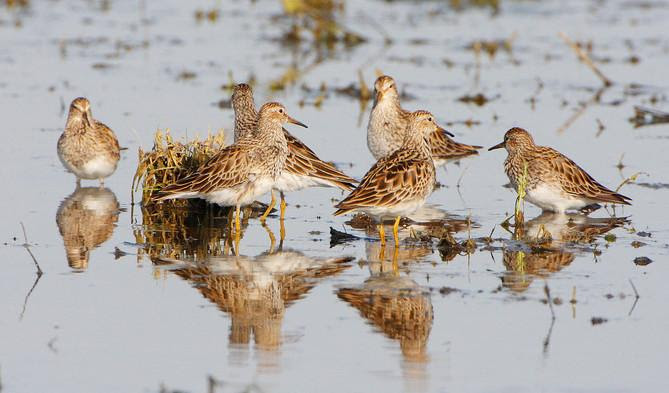Pectoral Sandpiper, Calidris melanotos
Bill Rowe
Here’s a typical flock of Pectoral Sandpipers, pausing at St. Louis on their immensely long spring journey from South America, where they winter, to their nesting grounds on the tundra of Canada or Alaska. After only 7-8 weeks of the brief Arctic summer, with its explosion of plant and insect life, their nesting is complete and their young are hatched and independent. By mid-July, most males take off again on a southward journey of thousands of miles to countries like Argentina, Bolivia, and Chile. Females leave a couple of weeks later, and juveniles later still. This means that the young make the trip on their own, without the guidance of the adults—another astonishing fact about their lives. En route, April-May and then July-September, large numbers pass through the center of North America, with Missouri right in their path. Millions of other shorebirds breed in the Arctic too, along with the Pectorals; thus they are all at risk from planetary warming.
IDENTIFICATION: Many sandpipers look somewhat alike, and the problem of identifying them lies partly in getting a close enough view as they feed in pools and on mudflats. If you see some Pectorals at fairly close range (or through a scope), you will know them by their (a) medium size, about like a starling; (b) overall mottled brown color, with a bib of dense fine streaks on the breast (the “pectoral” area) that is cut off sharply from the white belly; and (3) yellow legs. Overall they look very much like another common shorebird, the Least Sandpiper, but that one is much smaller, only the size of a sparrow. Adults and juveniles are pretty similar; see the photos below.
ST. LOUIS STATUS: The Pectoral is overall our most abundant sandpiper, often found by the dozens, sometimes the hundreds, and occasionally into the thousands if sufficient muddy habitat is around, as in the aftermath of a flood. It is also among the earliest of all our fall-migrant birds, with many arriving in July. Habitat is the main issue for finding them; the best spots change year to year and week to week as wet areas develop and dry up. No one place is managed especially for shorebirds.
Learn more and listen to the calls of Pectoral Sandpipers here.




